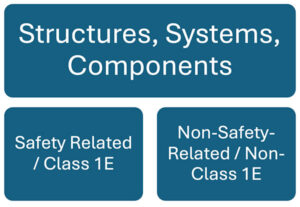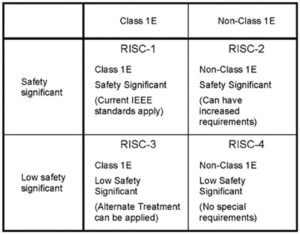September 2024
Use of risk-informed methods to categorize electrical and electronic systems and components in nuclear power plants has been shown to be safety-beneficial for nuclear power generating plants. Focusing attention on the safety-significant equipment results in increased safety as well as potential cost savings for the plant.

Historically the classification (Figure 1) of nuclear power plant structures, systems and components (SSCs) has been performed using long-established criteria in the governing regulations and industry standards. Beginning in the late 1990s, with the emphasis on use of plant probabilistic risk assessments (PRA) in regulatory decision making, interest developed regarding use of these PRAs to risk-inform the categorization and treatment of plant structures, systems and components based on the risks of their failures. In other words, increased focus and resources can be applied to safety-significant systems and components while allowing increased flexibility for items with low safety significance.
The U.S. Nuclear Regulatory Commission developed 10 CFR 50.69[1] to provide the regulatory framework for this approach. The Nuclear Energy Institute developed NEI 00-04[2] for the categorization of nuclear power plant SSCs. The categories developed are called Risk-Informed Safety Classes.
IEEE Std 1819[3] has been developed to provide methods to categorize electrical and electronic systems and components. These methods are considered necessary to facilitate appropriate classification of electrical and electronic equipment, since this equipment can have various functions and can serve many mechanical systems of various RISC categories. The NEI 00-04 RISC categories are used in this standard as well, substituting Class 1E for safety-related and non-Class 1E for nonsafety-related (Figure 2).

Other considerations are also used to determine the category assigned to a system or component, including: deterministic insights, maintenance of defense-in-depth, maintenance of sufficient safety margins, plant and industry operating experience, and operational and maintenance processes. An integrated decision making panel then reviews and approves the risk categorizations.
IEEE Std 1819 then provides some considerations for alternative treatment of the RISC-2 and RISC-3 equipment, e.g., design, specification, purchase, qualification, maintenance, surveillances, repair and replacement, and condition monitoring. (These alternative treatments are different than the special treatments required for RISC-1 equipment, but still provide reasonable confidence that the equipment will perform its required functions.)
IEEE Std 1819 is intended as the means to risk-inform 50 other traditionally deterministic IEEE Nuclear Power and Engineering Committee (NPEC) standards. Would you like to help inspire the next version of this first-of-a-kind, cutting-edge approach to risk-informing existing standards? If you are interested in serving a volunteer, contact NPEC WG 3.1 for details on how to get involved.
- 10 CFR 50.69, “Risk-informed categorization and treatment of structures, systems and components for nuclear power reactors”
- NEI 00-04, “10 CFR 50.69 SSC Categorization Guideline”
- IEEE Std 1819, “IEEE Standard for Risk-Informed Categorization and Treatment of Electrical and Electronic Equipment at Nuclear Power Generating Stations and Other Nuclear Facilities”
- 10 CFR 50.69, “Risk-informed categorization and treatment of structures, systems and components for nuclear power reactors”
(https://www.nrc.gov/reading-rm/doc-collections/cfr/part050/part050-0069.html) - NEI 00-04, “10 CFR 50.69 SSC Categorization Guideline”
(NEI publications are available from Nuclear Energy Institute (http://www.nei.org/). - IEEE Std 1819, “IEEE Standard for Risk-Informed Categorization and Treatment of Electrical and Electronic Equipment at Nuclear Power Generating Stations and Other Nuclear Facilities”

